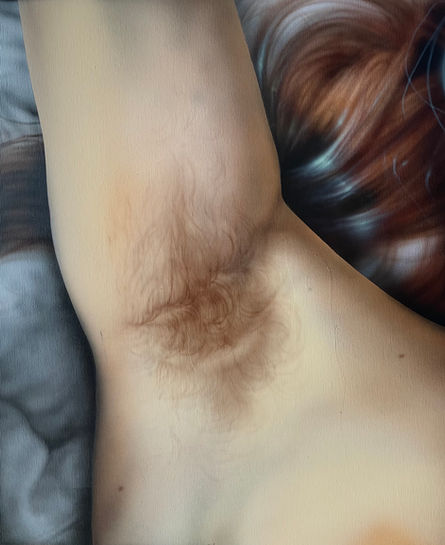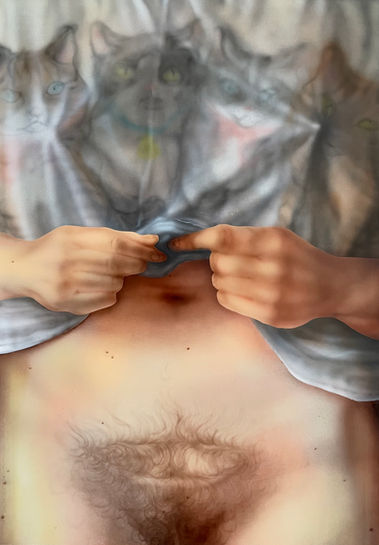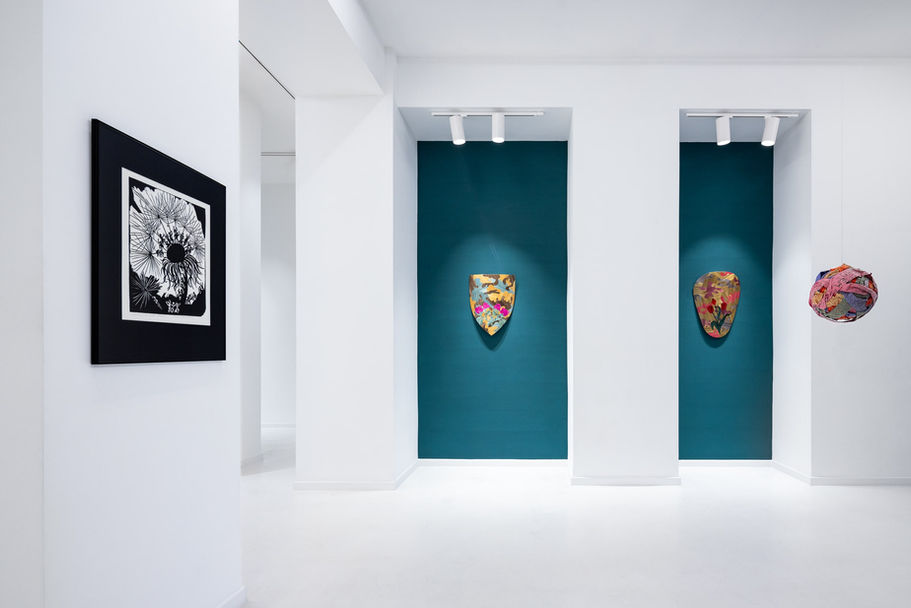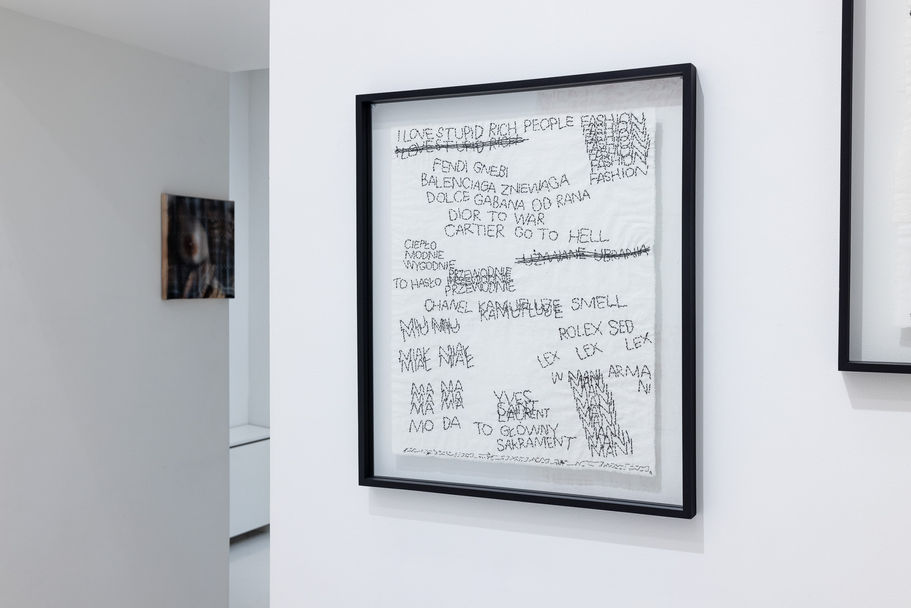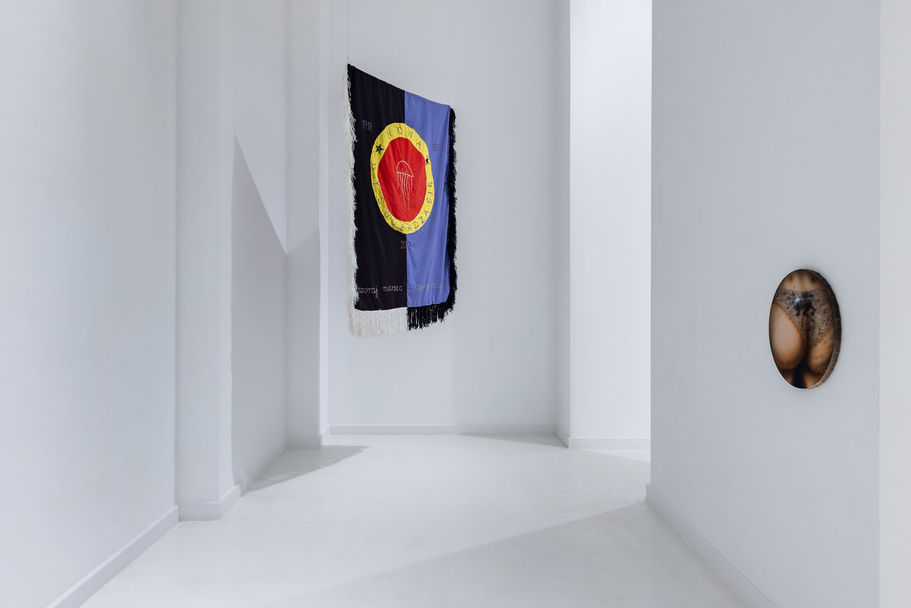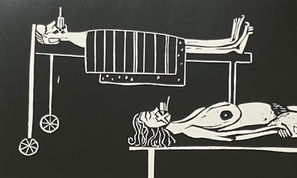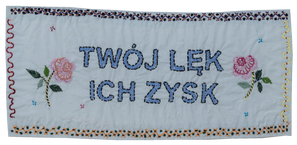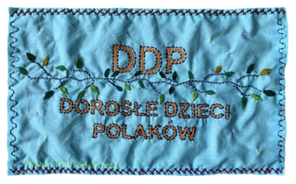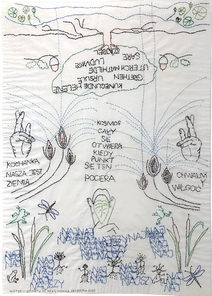SELF-SEEDERS
Monika Drożyńska, Teresa Jakubowska, Helena Minginowicz, Ala Savashevich
March 8 – April 27, 2024
They sow themselves, growing from seeds that have freeloaded here by gravity and gusts of wind. Self-seeders are untamed and uninvited, and as they grow without human intervention, they are often subject to control or eradication by the established order. A selection of the work of three generations of women artists featured in the exhibition evokes the associations of independence, determination and toughness encapsulated in nature.
The exhibition opens with prints by Teresa Jakubowska, which tell intimate stories from the life of the artist, born in Vilnius in 1930, including her experiences of war, expulsion and life in the post-war and socialist reality. She got married at a young age, and her marriage ended after barely nine years. She raised her children alone and bravely decided to move home and pursue her profession. Carved in wood or linoleum, the artist’s observations and reflections highlight women’s daily contributions: caring for others, nurturing relationships, and fighting for the right to equal self-determination.
Women’s determination and courage are also depicted in the works of Ala Savashevich. As an element of armour used for self-defence, the shields symbolise vigilance in the face of incoming blows, but also a state of readiness to repel them. Savashevich’s creations are made by using the technique of straw inlaying, creating a camouflage pattern with different types of flowers blooming in between. Today, shields are only used by uniformed services around the world to quell riots and protests. This is why the roses, tulips, orchids and lilies in Savashevich’s cycle are associated with the flowers held by demonstrators already from the 1960s as part of the opposition to the Vietnam War to the mass protests in Belarus in 2020 against Lukashenko’s regime and the brutality of the police. An important role in these events was played by the mass actions of Belarusian women, who expressed their disagreement without resorting to violence, thus creating a sense of solidarity in Belarusian society.
Monika Drożyńska calls herself a ‘die-hard embroiderer’ who skilfully combines a technique associated with ornamentation with the role of an activist involved in social projects. Her text embroideries can be found in the form of slaps, lurking in the corners of the urban fabric, or as small acts of vandalism, embroidered on the headrests of Polish Railways. Her feisty works are the result of a cultivated distance, often addressing political issues and challenging the established order to make room for what provokes emotion, discomfort and dissent. In her work, the artist analyses the role of language, which can be both inclusive and exclusive, creating divisions and animosities. Language shapes and changes our reality, so it is important to fight for the ability to speak freely, without discipline and subordination. The word ‘nature’ is feminine in most languages, usually evoking connotations of motherhood and fertility, but its moisture and tenderness can also shift the gaze from mother to lover. This is also the theme of ‘The Gospel to the Hags’, which was to be performed in the production of the play ‘Heksy’ [‘Hags’] by Agnieszka Szpila at the Dramatic Theatre in December 2023. Hags, the counterparts of the witches from Szpila’s novel, are women who have made a pact with the Old Maid and make love with nature as part of rituals, becoming advocates of a new kind of eroticism – eco-sexuality. Drożyńska employs fabric, a soft and expansive material, in contrast to the rigidity that symbolises both patriarchal power hierarchies and the rigidity of art canons.
Continuing the theme of eroticism, Helena Minginowicz’s latest canvases blossom with buttocks, bottoms and rumps arched, glistening with sweat, with swollen breasts, nipples more or less rebelliously slipping from lace restraints. The bodies in Minginowicz’s paintings resist imposed standards of beauty, deriving satisfaction from their naturalness and, despite all the shame and prudery, waiting for fulfilment and self-love. Minginowicz also captures simple scenes from everyday life. In the piece ‘Wyczyść stół!’ | ‘Clear the table!’ she highlights the objectification of those who take on the role of nurturers and caretakers in the domestic sphere, tasked with to cleaning and cooking. A feast for some often comes at the cost of an extra job for others, a duty that consumes time that should be devoted to rest and pleasure. Our bodies are curious, living instruments of cognition, but also transmitters and receivers. Minginowicz observes the emotions and behaviours revealed by the body that our psyche carefully hides from the world. The micro-worlds painted by the artist are projections that we often suppress and block for fear of being labelled inappropriate, ridiculous or naive. Constellations of experiences and emotions eventually find an outlet, crawling out of the body with or without our consent. Minginowicz traces moments of liberation from the shackles of control, brief instances of demystification that expose our desires and hidden weaknesses.
The narratives presented in the exhibition speak of women’s burgeoning strength, resilience and awareness of the need to constantly strive to realise and transform themselves. Not to resist difficulties, emotions, rebellions and pleasures. Experiences, even the difficult and unpleasant ones, shape sensitivity, nourish intuition, emotionality and a creative attitude. The need to express these values is deeply rooted in many women artists, who are in constant need of natural development. Stifling intuition, humility and stagnation are against their nature. Thus, in full readiness for the new, in fear of atrophy, even the slightest breeze is seen as a reason for action, self-determination and blossoming.
Curator: Katarzyna Piskorz
Monika Drożyńska (b. 1979, Nowy Sącz)
Visual arts artist and activist embroiderer. Graduate and doctoral student at the Jan Matejko Academy of Fine Arts in Krakow. Pioneer of embroidery techniques in contemporary art and textiles in public space. She is interested in language, which she explores using hand embroidery on fabric. She has cooperated with the POLIN Museum, the Zachęta National Gallery of Art, Ujazdowski Castle Centre for Contemporary Art, Wrocław Contemporary Museum, Mumok in Vienna, the Ludwig Museum in Budapest, Bozar Centre for Fine Arts in Brussels, Sotheby's Tel Aviv. Her works are in the collection of Bunkier Sztuki Gallery of Contemporary Art in Cracow, the National Museum in Cracow, the MOCAK Museum of Contemporary Art in Cracow, the National Museum in Kiev, Lentos in Linz, Austria.
Teresa Jakubowska (b. 1930, Vilnus)
Graphic artist. From 1948 to 1953 she studied at the Faculty of Fine Arts at the Mikołaj Kopernik University in Toruń, where she obtained her diploma in the atelier of Professor Jerzy Hopper. She was a member of Association of Polish Artists and Designers (1954-1983), the 'Toruń Group' (1958-1969), International Association of Arts (since 1955), and the International Association of Wood Engravers WYLON in Switzerland (since 1978). She was working in Toruń and since 1969 in Warsaw. She received a distinction at the First and Second Symposium "Złote Grono", (Zielona Góra 1963,1965), as well as many prizes, medals and distinctions at reviews and in environmental and graphic competitions. In 1963, together with Józef Gielniak, she represented Poland at the Paris Biennale of Young Artists. She presented her works at over 180 individual exhibitions in Poland and abroad.
Helena Minginowicz (b. 1984, Poznan)
Graduate of the Faculty of Architecture and Design at the Magdalena Abakanowicz University of Arts in Poznań (2011). Finalist of the Bielska Jesień 2023 contest, she lives and works in Poznań. She has presented her works in solo and group exhibitions: "Sticky handshakes" (Art Walk, Warsaw 2024), , "Everyday Stories" (Gallery M, Wrocław 2023), "Lies of summer" (Dystans Gallery, Kraków 2023), "Beautiful Creatures" (PIREUS Culture Incubator, Poznań 2022), "Ideal Lovers" (City Gallery, Środa Wielkopolska 2021), "About the Stars" (Peryskop, Wrocław 2020).
Ala Savashevich (b. 1989, Stolin, BY)
Creates sculptures, installations and video works. She studied sculpture at the Belarusian State Academy of Art in Minsk and the Eugeniusz Geppert Academy of Fine Arts in Wrocław, currently a doctoral student at the Academy of Fine Arts in Kraków. Her work explores themes of collective memory and identity formation in societies with experience of authoritarianism and patriarchy. She is particularly interested in the mechanisms of socialisation into the role of women in family, educational systems and through a gendered division of labour. She lives and works in Wrocław.
the project is co-financed by the Capital City of Warsaw

photo: Szymon Sokołowski (meta_stron_fiction)




